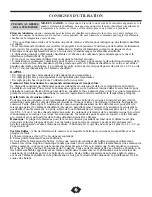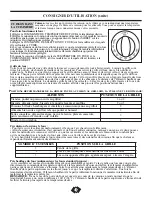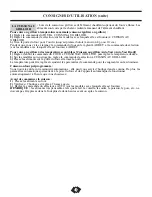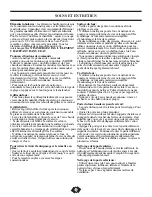
IMPORTANT SAFETY INFORMATION (cont’d)
4
IMPORTANT
SAFEGAURDS (cont’d)
• Allow parts to cool to room temperature before touching or removing them from the range. When a surface
element is first turned off, the element can be hot enough to cause burns.
• Clean the range regularly to keep all parts free of fat or grease which could catch fire. Exhaust fan
ventilating hoods and grease filters should be cleaned regularly. Do not allow fat or grease to accumulate.
Greasy deposits in the fan could catch fire. Refer to the hood manufacturer’s instructions for cleaning.
• Glazed Cookware: Only certain types of glass, glass/ceramic, ceramic, earthenware, or other glazed
cookwares are suitable for rangetop service without breaking, due to the sudden change in temperature. Check
the cookware manufacturer’s recommendations for rangetop use.
• Do not place plastic salt and pepper shakers, spoon holders, or plastic wrappings on top of the range. These
items could melt or ignite.
• Do not use trailing towels, damp cloths or aprons when handling pots and pans. Always use dry mitts or
potholders to prevent accidents.
• Do not use a wok equipped with a metal ring that extends beyond the burner. Because this ring traps heat,
the element and grate could be damaged.
• Do not clean the oven door gasket. The door gasket is essentially for a good seal. Care should be taken not to
rub, damage, or move the gasket.
• It is good practice for each household to have an appropriate fire extinguisher for use in the event of a house
fire.
• Disconnect the range from electrical supply before attempting to service or move it.
NOTE:
The instructions appearing in this owner’s guide are not meant to cover every possible condition and
situation that may occur. Common sense and caution must be practiced when operating and maintaining any
appliance.
ENERGY
SAVING TIPS
Surface Cooking:
• Use lids when surface cooking. A lid traps steam and uses it to speed up the cooking process. If you have a
pressure cooker or vegetable steamer, use it. You will save time and cut energy costs.
• Use medium-weight, flat bottomed pans. Choose pans made of metals that conduct heat well.
• When cooking on a surface burner, use as little water as possible to reduce cooking time.
Oven Cooking:
• Preheat the oven only when a recipe tells you. Put roasts and casseroles into a cold oven, then turn the oven on.
• Opening the oven door often to check on foods wastes energy.
• Use the oven to prepare complete meals. For instance, start a roast, add vegetables when the meat is half-
cooked, and then warm rolls or dessert after the main dishes are cooked.
• Thaw frozen foods before cooking. Thawed food requires less cooking energy than frozen food.
• Make it a habit to turn the oven off before removing the cooked food.






































